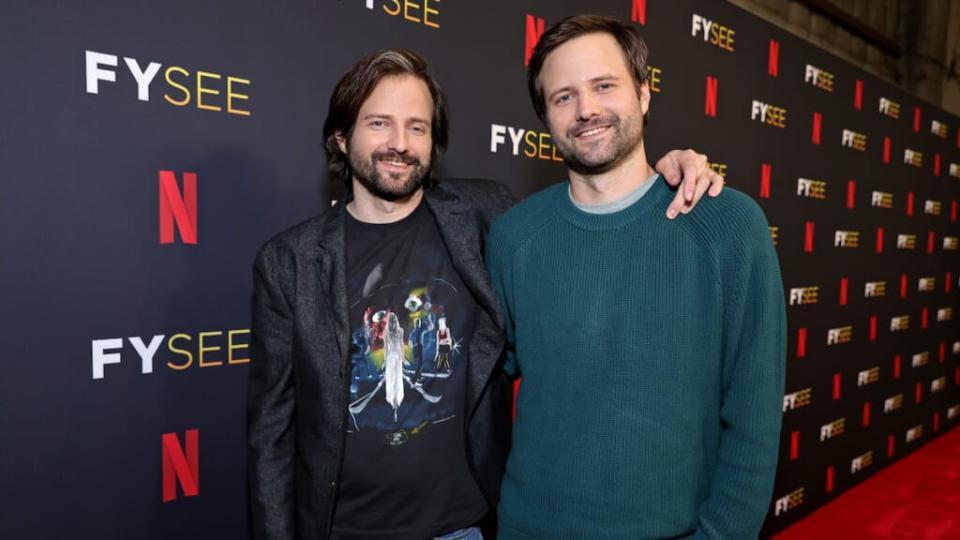What Netflix’s $200 Million Bet on ‘The Gray Man’ Says About the Streamer’s Film Franchise Future
Netflix is in major need of a movie franchise hit, and it’s obvious why they would look to directors Anthony and Joe Russo (“Avengers: Endgame”) to find it with “The Gray Man,” which opened for a one-week theatrical run this weekend before hitting the streamer Friday.
But a franchise hit may not be all that Netflix needs to boost its fortunes, and with a budget north of $200 million, a lot needs to go right for “The Gray Man” to show that Netflix’s strategy as a film studio is on the right track.
The Russo brothers always envisioned Mark Greaney’s 11 “Gray Man” books as a long-term action franchise well before the project landed at Netflix. But analysts and experts who spoke to TheWrap questioned whether big-budget tentpole sequels actually drive significant subscriber growth, and whether the enormous production cost makes financial sense without a broad theatrical strategy in tandem with streaming.
Also Read:
Surprise Netflix-Microsoft Ad Partnership May Be the First Step in a Larger Strategy | Analysis
“I think their hope is that they will hit gold at some point,” Bruce Nash, an analyst with The Numbers and Nash Information Services, told TheWrap. “Netflix’s biggest weakness compared to Disney+ and HBO Max is that they don’t have exclusive rights to a major film franchise, so I think it makes sense for them to keep trying to fill that gap.”
“What impression does it give people of Netflix moving forward? Is it more of a direct-to-video streamer where you have a high output of lower quality titles? Or is it a service where they can see marquee, original IP being debuted,” Paul Erickson, a senior analyst with Parks Associates, countered. “I think it’s the latter. It’s going to be concentrated on fewer titles but higher quality IP. And that’s not a foreign concept for the industry, because we already see HBO Max doing that.”
But finding that franchise is a struggle. In fourth-quarter 2021, Dwayne Johnson’s “Red Notice,” which likewise had a $200-plus million price tag, quickly became Netflix’s most-watched original film in its history. Yet the viewership for that film, plus the combo of its second biggest film “Don’t Look Up” and ongoing “Squid Game” buzz, were not enough to help Netflix hit its subscriber expectations for the quarter.

One expert at a production and financing company noted that Netflix has proven willing to take the chances on non-IP-based big budget movies that even other studios won’t. They didn’t doubt Netflix’s eagerness to spend, but said they felt Netflix’s mandates are frequently changing.
Netflix declined to comment for this story, but the streamer’s film chief Scott Stuber gave an overview of his strategy when interviewed at TheWrap’s Grill conference:
“I came here with the recognition that I was starting at the bottom, that we are in last place, meaning that in the film industry, we were going to have to build a film studio and prove ourselves… We have no library, we have no IP, what are we going to do to define ourselves?” Stuber told TheWrap last fall. “This has always been a long-term plan for me. How do we get to the place where everyone at some point in the next five years goes, ‘That’s the best film studio in the world?’ And that’s something we’re trying to do.”
Also Read:
‘The Gray Man’ Film Review: Ryan Gosling and Chris Evans Coast on Charm Through Patchy Action Movie
Jeff Bock, senior media analyst with Exhibitor Relations, said that it’s hard to truly gauge the success of any of these films or their big spends without box office receipts to use as comparisons.
In the case of “The Gray Man,” the film opened Friday, just one week ahead of its streaming debut at more than 1500 theaters in 25 countries, including approximately 450 in the U.S. and Canada in 120-plus markets, primarily in several Cinemark locations as well as other theater chains. Netflix doesn’t report box office figures, but Deadline reported that “The Gray Man” domestically made under $200,000 in its first weekend.
Compare that to the theatrical rollout for “Red Notice,” which opened on roughly 750 screens domestically last fall, and reportedly made between $1.25-$1.5 million in its opening, with Cinemark ultimately announcing it was the most successful Netflix film to ever play in its theaters.
“They haven’t made a huge amount of money for Netflix, but they have filled the theaters they’ve played in, and I think it’s a viable strategy for Netflix in terms of raising awareness of their films and potentially making some money from an alternative source,” Nash said. “The point of contention will always be the size of the theatrical window, particularly for streamers like Netflix that have such a large subscriber base. One week of theatrical exclusivity wouldn’t be enough, I think, but I can imagine ‘Knives Out 2’ playing in theaters over Thanksgiving and debuting on Netflix on Christmas Eve, for example.”
Also Read:
Netflix’s Ad Agency Palisades Media Suddenly Closes Up Shop (Exclusive)
Netflix has has two “Red Notice” sequels in development with stars Johnson, Gal Gadot and Ryan Reynolds all expected to return, but sequels for some of Netflix’s other most expensive hits such as “Bright” and “6 Underground” have yet to materialize. Instead, Netflix is only now in the works on follow-ups to some of its more mid-budget hits, including “The Old Guard 2,” “Enola Holmes 2” and “Extraction 2,” which also hails from the Russo brothers’ AGBO banner. And it’s also found success with its lower-budget teen films like the “To All the Boys,” “The Kissing Booth” and “The Princess Switch” franchise, among others.
But despite some massive numbers — “Red Notice” was viewed for 364 million hours in its first 28 days on the service and lasted in its Global Top 10 List for 10 weeks — analysts argue these films don’t have the same shelf life or cultural cache of their many hit series.
“‘Cocomelon’ has more staying power than their big-budget popcorn pics. Simply put — they’re disposable. ‘Stranger Things’ is still their most popular homegrown success and that’s a series, not a film,” Bock said. “There’s rarely a film poster that can hold a candle to the most basic theatrical rollout, much less be hung in a dorm room. These films not only seem disposable, they are disposable. [They’re] not much in the way of lasting appeal.”
Many analysts’ are watching whether Netflix decides to tweak its theatrical approach for the holiday release of “Glass Onion,” Rian Johnson’s follow-up to the box office smash “Knives Out,” and which Netflix plunked down a massive $400-plus million to acquire the rights to both it and a second sequel. But there’s no indication such a shift will happen any time soon, and each of Netflix’s theatrical strategies, be it for a tentpole blockbuster or an awards contender, remain bespoke.

The production and financing expert argued that Netflix needs to overpay for big event pictures if it wants to attract talent and keep them in their wheelhouse. They added it’s something that has made Netflix one of the best when it comes to giving talent creative freedom. That approach paid off just this month when “Stranger Things” creators the Duffer brothers signed a massive deal with Netflix to produce other shows, movies and a “Stranger Things” spin-off.
“There has to be the endgame or the bottom line result has to be putting this much money into a single film, one movie, has to somehow pay dividends,” Paul Dergarabedian, senior media analyst with Comscore, said. “Those dividends could be filmmaker or creative talent loyalty or creating good will with really important and well known A-list talent in front of and behind the camera. In that calculus may not be the cold hard dollars and cents or traditional metrics.”
And that calculus could change when Netflix finally introduces an ad-based subscription model that can bring in additional downstream revenue and make up for what they might be losing in theatrical box office. The expert believes that should this happen soon, it would allow them to continue to support making multiple, big budget tentpoles at their current pace.
But analysts are split on whether quality or quantity will make the most difference moving forward.
“Think of how many low-budget horror flicks they could have made for $200 million instead of one ‘The Gray Man,’ which won’t even be a box office blip and will probably slip outside their own Top 10 in a matter of a few weeks,” Bock said. “They’re trying to play the old Hollywood game in the confines of new Hollywood. Big budget Hollywood films go through a production pipeline that has been developed for decades — there are no shortcuts and Netflix is finding that out firsthand.”
While “Red Notice” and “The Gray Man” were each greenlit at a different time not just for Netflix but for the industry at large, Netflix has also remained vocal about not slowing down its content spend. Ted Sarandos told a J.P. Morgan and Chase analyst back in April that he expected content spend for 2022 to be “around $18 billion,” which would be up from the $17 billion it spent in fiscal 2021.
“I think we’ve got to continue to invest in the content, both in the quality and the variety of the content. And we will continue to grow the content spend relative to prior years,” Sarandos said.
With any luck, that would manifest in a “Gray Man” sequel, and Netflix is still committing to action films in particular, which are among its best performing movies. The streamer out of Cannes spent $50 million to acquire an Emily Blunt package called “Pain Hustlers.” And even on the comedy end, one source indicates that the upcoming “Murder Mystery 2” with Adam Sandler and Jennifer Aniston is shaping up to be the streamer’s most expensive comedy ever, with a budget even on par with some of its biggest tentpoles.
“Netflix is very audacious in everything they do. If they lose a lot of subscribers or there’s still a lot of churn, they still go all in on a movie like ‘The Gray Man.’ The future is going to be about weighing the cost benefit,” Dergarabedian added. “It’s an expensive bet, but it may be about filmmaker and talent relationships as well that are an investment or an annuity in the future for Netflix. And in a year from now, everything can be different.”
Also Read:
Why Film Producers Are So Excited About the Metaverse: ‘Everybody’s Dream Can Come True’

